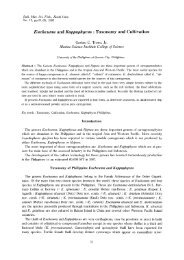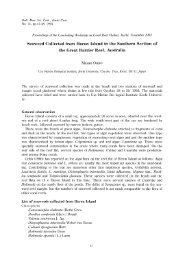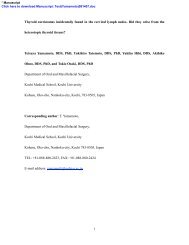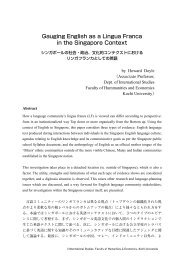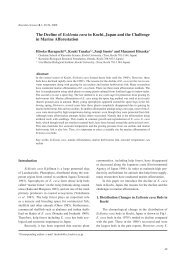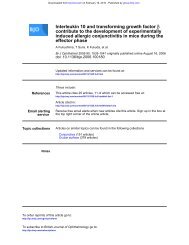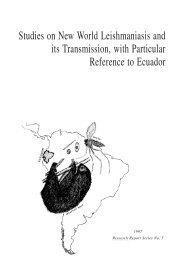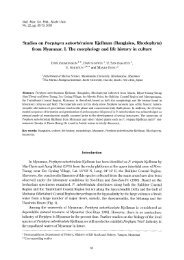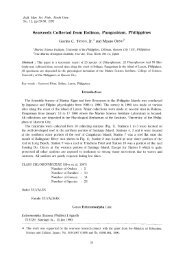Changes in soil bacterial community profiles associated with ...
Changes in soil bacterial community profiles associated with ...
Changes in soil bacterial community profiles associated with ...
Create successful ePaper yourself
Turn your PDF publications into a flip-book with our unique Google optimized e-Paper software.
Soil <strong>bacterial</strong> communities reflect<strong>in</strong>g land degradation53ord<strong>in</strong>ation analysis. Geoderma 49: 1-32.Ol<strong>in</strong>e, D. K., Grant, M. C., 2002. Scal<strong>in</strong>g patterns of biomass and <strong>soil</strong> properties: an empirical analysis. Landscape Ecology 17:13-26.Palmer, K. M. & Young, J. P. W. 2000. Higher diversity of Rhizobium legum<strong>in</strong>osarum biovar viciae populations <strong>in</strong> arable <strong>soil</strong>sthan <strong>in</strong> grass <strong>soil</strong>s. Applied and Environmental Microbiology 66: 2445-2450.Pankhurst, C. E., Yu, S., Hawke, B. G. & Harch, B. D. 2001. Capacity of fatty acid <strong>profiles</strong> and substrate utilization patternsto describe differences <strong>in</strong> <strong>soil</strong> microbial communities <strong>associated</strong> <strong>with</strong> <strong>in</strong>creased sal<strong>in</strong>ity or alkal<strong>in</strong>ity at three locations <strong>in</strong>South Australia. Biology and Fertility of Soils 33: 201-17.Pillai, S. D. and Pepper, I. L. 1991. Transposon Tn5 as an identifiable marker <strong>in</strong> rhizobia: survival and genetic stability of Tn5mutant bean rhizobia under temperature stressed conditions <strong>in</strong> desert <strong>soil</strong>s. Microbial Ecology 22: 21-33.Pote, J., Ceccher<strong>in</strong>i, M. T., Van, V. T., Rosselli, W., Wildi, W., Simonet, P. & Vogel, T. M. 2003. Fate and transport ofantibiotic resistance genes <strong>in</strong> saturated <strong>soil</strong> columns. European Journal of Soil Biology 39: 65-71.Roane, T. M. & Kellogg, S. T. 1996. Characterization of <strong>bacterial</strong> communities <strong>in</strong> heavy metal contam<strong>in</strong>ated <strong>soil</strong>s. CanadianJournal of Microbiology 42: 593-603.Ramos, M. L. G., Magalhanes, N. F. M. & Boddey, R. M. 1987. Native and <strong>in</strong>oculated rhizobia isolated from field grownPhaseolus vulgaris: effects of lim<strong>in</strong>g an acid <strong>soil</strong> on antibiotic resistance. Soil Biology and Biochemistry 19: 179-185.Sakurai, K., Tanaka, S., Ishizuka, S. & Kanzaki, M. 1998. Differences <strong>in</strong> <strong>soil</strong> properties of dry evergreen and dry deciduousforests <strong>in</strong> the Sakaerat Environmental Research Station. Tropics 8: 61-80.Sena, M. M., Poppi, R. J., Frighetto, R. T. S. & Valar<strong>in</strong>i, P. J. 2000. Avaliação do uso de métodos quimiométricos em análisede solos. Química Nova 23: 547-556.Staddon, W. J., Duchesne, L. C. & Trevors, J. T. 1997. Microbial divesity and <strong>community</strong> structure of postdistrubance forest<strong>soil</strong>s as determ<strong>in</strong>ed by sole-carbon-source utilization patterns. Microbial Ecology 34: 125-130.Stevenson, I. L. 1954. Antibiotic production by act<strong>in</strong>omycetes <strong>in</strong> <strong>soil</strong> demonstrated by morphological changes <strong>in</strong>duced <strong>in</strong>Helm<strong>in</strong>thosporium sativam. Nature 174: 598.Stohlgren, T. J. & Bachand, R. R. 1997. Lodgepole p<strong>in</strong>e (P<strong>in</strong>us contorta) ecotones <strong>in</strong> Rocky Mounta<strong>in</strong>i National Park,Colorado, USA. Ecology 78: 632-641.ter Braak, C. J. F. & milauer, P. 1998. Canoco reference manual and user’s guide to Canoco for w<strong>in</strong>dows: software forcanonical <strong>community</strong> ord<strong>in</strong>ation (vesion 4). Microcomputer Power, Ithaca, NY.USDA Soil Conservation Service 1975. Soil taxonomy, a basic system of <strong>soil</strong> classification for mak<strong>in</strong>g and <strong>in</strong>terpret<strong>in</strong>g <strong>soil</strong>surveys. John Willey and Sons, Inc. New York.van den Br<strong>in</strong>k, P. J., van Wijngaarden, R. P. A., Lucassen, W. G. H., Brock, T. C. M. & Leeuwangh, P. 1996. Effects of the<strong>in</strong>secticide Dursban ® 4E (active <strong>in</strong>gredient chlorpyrifos) <strong>in</strong> outdoor experimental ditches: II. <strong>in</strong>vertebrate <strong>community</strong>responses and recovery. Environmental Toxicology and Chemistry 15: 1143-1153.van Straalen, N. M., 2002. Assesment of <strong>soil</strong> contam<strong>in</strong>ation-a functional perspective. Biodegradation 13: 41-52.Velkov, V. V. 1999. How environmental factors regulate mutagenesis and gene transfer <strong>in</strong> microorganisms. Journal ofBioscience 24: 529-559.Wali, M. K. 1999. Ecological succession and the rehabilitation of disturbed terrestrial ecosystem. Plant and Soil 213: 195-220.Westover, K. N., Kennedy, A. C. & Kelly, S. E. 1998. Patterns of rhizosphere microbial <strong>community</strong> structure <strong>associated</strong> <strong>with</strong>co-occurr<strong>in</strong>g plant species. Journal of Ecology 85: 863-873.Wren, A. B. & Venosa, A. D. 1996. Selective enumeration of aromatic and aliphatic hydrocarbon degrad<strong>in</strong>g bacteria by amost-probable-number procedure. Canadian Journal of Microbiology 42: 252-258.Yang, C.-H., Crowley, D. E. & Menge, J. A. 2001. 16S rDNA f<strong>in</strong>gerpr<strong>in</strong>t<strong>in</strong>g of rhizosphere <strong>bacterial</strong> communities <strong>associated</strong><strong>with</strong> healthy and phytophthora <strong>in</strong>fected avocado roots. FEMS Microbiology Ecology 35: 129-136.Zak, J. C., Will<strong>in</strong>g, M. R., Moorhead, D. L. & Wildman, H. G. 1994. Functional diversity of microbial communities: aquantitative approach. Soil Biology and Biochemistry 26: 1101-1108.Zar, J. H. 1999. Biostatistical analysis. Prentice-Hall, New Jersey.Received 27 th Oct. 2003Accepted 07 th Apr. 2004



